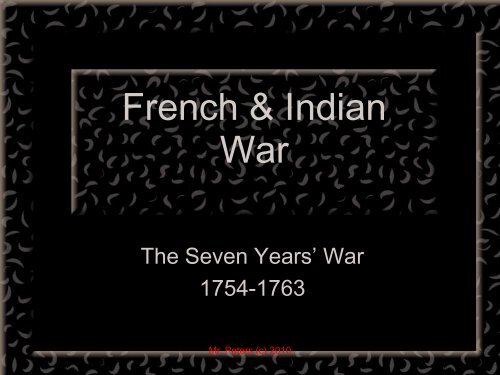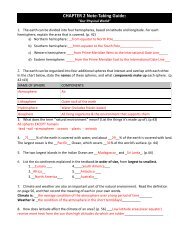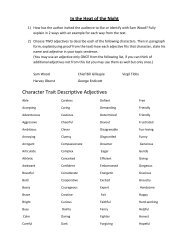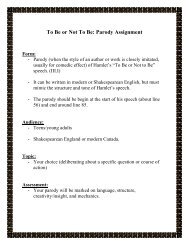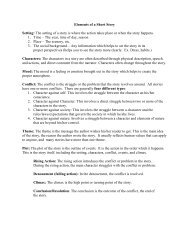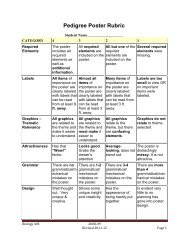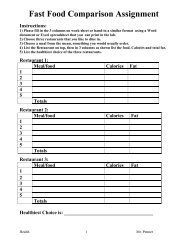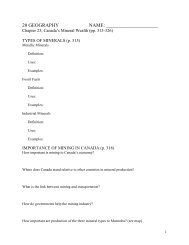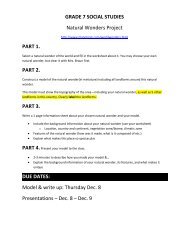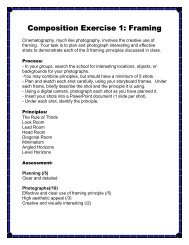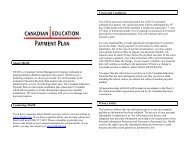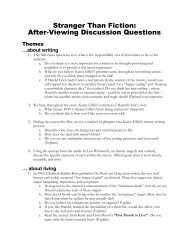Create successful ePaper yourself
Turn your PDF publications into a flip-book with our unique Google optimized e-Paper software.
<strong>French</strong> & <strong>Indian</strong><br />
<strong>War</strong><br />
The Seven Years’ <strong>War</strong><br />
1754-1763<br />
Mr. Peters (c) 2010
A. 1753 … It Begins<br />
• Major George Washington is sent on a<br />
reconnaissance (spy) mission into the Ohio Valley to<br />
establish American claims to the area, and to let the<br />
<strong>French</strong> know their presence was unwanted.<br />
• He made it to Fort Le Bouef, on the shores of Lake<br />
Erie.<br />
• In 1754, a now Lt. Col. Washington was sent to build<br />
a fort near present-day Pittsburgh, PA, which they<br />
called Fort Duquesne.<br />
• The <strong>French</strong> attacked, causing Washington’s forces to<br />
retreat, during which they build another fortification<br />
called Fort Necessity.<br />
• On July 4, 1754, Washington surrendered this fort as<br />
well and was captured, and released by the <strong>French</strong>.<br />
Mr. Peters (c) 2010
B. “The Shot Heard Around<br />
the World”<br />
• Washington’s failed expedition into the Ohio Valley<br />
would touch off what one historian wrote as, “The<br />
volley by a young Virginian in the backwoods of<br />
America set the world on fire.”<br />
• After the previous war between England and France,<br />
known as the <strong>War</strong> of the Austrian Succession (1740-<br />
1748), France built a series of fortifications across the<br />
Great Lakes, through the Ohio Valley, and down the<br />
Mississippi.<br />
• The purpose was to contain the British menace (the<br />
Thirteen Colonies).<br />
Mr. Peters (c) 2010
Mr. Peters (c) 2010
• The Americans had a genuine fear, that<br />
should war break out between France<br />
and Britain again, that they would be<br />
caught between two hostile powers:<br />
– France to the north and west<br />
– Spain to the south<br />
• The <strong>French</strong> & <strong>Indian</strong> <strong>War</strong> (Seven Years<br />
<strong>War</strong> to Europeans), became the first<br />
world war to be initiated in North<br />
America and spread to Europe.<br />
Mr. Peters (c) 2010
C. Acadia<br />
• Throughout 1755, the British suffered a series of<br />
defeats because the <strong>French</strong> skillfully outsmarted the<br />
mainly colonial militia by projecting military power<br />
without exercising it, and by relying on more<br />
experienced field commanders.<br />
• As a consequence, the British feared a “fifth column”<br />
appearing in Acadia, so they deported the <strong>French</strong>speaking<br />
population to the Thirteen Colonies,<br />
Louisiana, and France.<br />
• This event marks one of the darkest periods in<br />
Canadian History, as a governing authority sought<br />
the extermination of a race of people by removing<br />
them from their ancestral land.<br />
Mr. Peters (c) 2010
D. The Battle for Quebec<br />
• In 1756, an able Prime Minister by the<br />
name of William Pitt, took charge. He at<br />
once formulated a plan of attack:<br />
– A coastal invasion of Quebec, with the<br />
object being the capture of the fortress of<br />
Quebec City.<br />
– An invasion from the Thirteen Colonies,<br />
with the object being the capture of<br />
Montreal.<br />
Mr. Peters (c) 2010
• In 1759, British General Wolfe executed a daring plan<br />
of attack on Quebec:<br />
– Earlier in the year he had tried to lure the <strong>French</strong><br />
General Montcalm onto the field of battle by<br />
launching raids up and down the coast, but this<br />
strategy failed.<br />
– The time was late fall and he had to attack quickly<br />
to avoid being frozen in the St. Lawrence.<br />
– In desperation, he ordered his men to climb a<br />
steep cliffside, under cover of darkness, onto the<br />
Plains of Abraham, in front of Quebec City.<br />
– Though Montcalm could have withstood a siege<br />
long enough to allow winter to claim the British, he<br />
instead gave battle.<br />
Mr. Peters (c) 2010
• As a consequence, Wolfe was able to<br />
decisively defeat Montcalm in a bloody<br />
and brief battle. Both commanders<br />
were killed during the melee.<br />
• In 1760, the British captured Montreal<br />
and the war came to an effective end in<br />
North America, though it continued to<br />
rage on in Europe until 1763.<br />
Mr. Peters (c) 2010
Treaty of Paris (1763)<br />
• France officially ceded all of its holdings in<br />
North America, west of the Mississippi; while<br />
regaining the Islands of Guadeloupe and<br />
Martinique (the British offered Canada for<br />
these islands, but the <strong>French</strong> refused).<br />
• For Canada, this marked the end of <strong>French</strong><br />
rule and the beginning of British, and would<br />
form the basis of what was British North<br />
America and what would become the<br />
Dominion of Canada in 1867.<br />
Mr. Peters (c) 2010
• The strategic impact of the war on<br />
global affairs was thus:<br />
– The cost of the war and of controlling the<br />
newly acquired territories was high. The<br />
British looked to the colonies to help pay<br />
those costs. That began the long spiral of<br />
events that led to the American Revolution.<br />
– In effect, the Seven Years <strong>War</strong> would<br />
ultimately be responsible for our current<br />
world order – the United States as a global<br />
superpower.<br />
Mr. Peters (c) 2010


